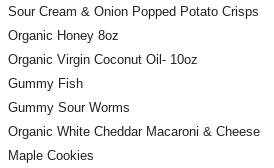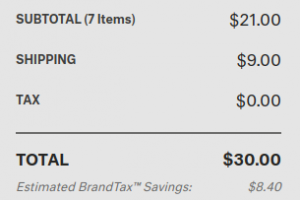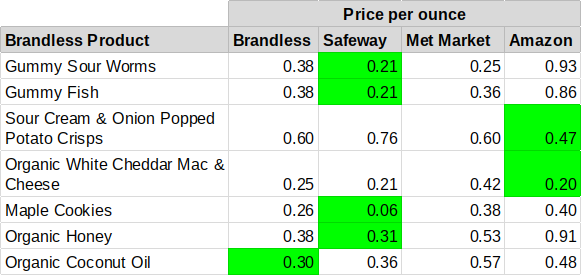This week’s post will be about my review of the food I ordered from Brandless, along with my revised thoughts on this quirky online company. For context, my previous post about Brandless can be found here. My classmates and fellow writers on this blog helped clarify for me why this website gives us such an odd feeling, and what it says about the consumption behaviors of millennials today. But first, my review.
Last Wednesday, I made an order on Brandless’s website. They offer a $3 shipping cost on your first order, compared to the regular $9 shipping. (Once I placed my order, however, I got an email from Brandless offering $1 shipping, which was a little annoying.) Here’s my order:
I got to the checkout and, along with my subtotal along the side of the screen, it also showed me my estimated BrandTax savings. (Also, yes, BrandTax is trademarked.)
I would love to know how exactly they got that number but they offered me nothing more, just that I allegedly saved $8.40 by shopping here.
I don’t know if this sounds entitled, but it took an entire day to begin shipping, so it didn’t end up arriving until Monday. In the world of Amazon two-day shipping, this was a moderately long process for me. Once it arrived, I opened up the box to find this obnoxious packaging:
The letter inside that envelope welcomed me to Brandless and informed me that my purchase would go towards Feeding America, which is confirmed not true. That initiative ended September 30th, or possibly even earlier, as their website states: “Offer valid from September 1, 2017, until September 30, 2017, or until maximum is reached.” My order was placed on October 5th, and that date is printed two inches above the statement about Feeding America, so they knowingly included this defunct promotion in my welcome letter. Anyway, back to the food.
The sour cream and onion popped potato crisps were the first thing I went for. They were yummy and pretty much exactly like Popchips, which I assume is what they were attempting to emulate. The organic honey and virgin coconut oil were for friends and I don’t think they’ve tried them. They’re pretty straightforward; I assume Brandless couldn’t mess that up. We’ll get into whether the price was worth it later on, though. The gummy fish and gummy sour worms had a good, more natural flavor and were gelatin free (I’m vegetarian), which is somewhat rare to find. They had a thicker consistency, though. More like fruit snacks than gummy candy. The organic mac and cheese was actually 2 for $3, so each box cost $1.50. I’d already read a review on this product that said the mac and cheese was tasteless, which I can confirm. It was buttery, but definitely didn’t have enough cheese. It was organic and free of artifical colors, flavors, and preservatives, which I’m pretty sure is true of Annie’s mac and cheese, a comparable product. However, I kind of felt grosser after eating this mac and cheese than I do after eating Annie’s. Finally, the maple cookies were delicious, which makes sense, because they were filled with sugar.
I took a trip to the Metropolitan Market and Safeway, and looked at Amazon’s online prices, to find the most comparable product for each of my purchases, and figure out if Brandless really offers a deal. I add the caveat that in some instances, I couldn’t find a comparable product that had the same attributes–organic, non-GMO, etc.–so this is a possible explanation for the price discrepancy. In almost every case for Amazon, though, I was able to find a very similar product. Here are the numbers:
The cells highlighted green are the ones that had the best price in that category. As we can see, Brandless wins in only one category–coconut oil. Granted, Brandless may have won in the sour cream and onion chips category had the chips not been on sale at Safeway and the Met, but even then, Amazon beats all three of them. I suppose I can see the gummy candies being the best deal at Brandless because the truest comparable product is much more expensive on Amazon. This website, then, is really for people who care about their food being organic, non-GMO, and free of preservatives or artificial colors or flavors, and that’s commendable. But only in specific cases is it true that one can’t find an alternative anywhere else.
I spoke to my class about this website, and we had a good conversation about what it is exactly that irks us about this website. One of my classmates said that it sounds like a half-assed attempt at anti-consumerism marketed towards young people. Another said that the language they used bothered him. Here are some excerpts from Brandless’s “About Us” page: “Brandless was brought to life on July 11, 2017”. “Everything that’s Brandless is also bad-stuff-less and goodness-ful”. “We’re a group of thinkers, eaters, doers, and lovers of life”. The marketing strategy of Brandless seems to be chumming up to the consumer and blurring the line between corporation and “group of people with great ideas”. My classmate says he would feel more comfortable with this company if they were more impersonal and robotic, the way a corporation typically is.
My intuition about this is that millennials more than any other group are having to grapple with what it is to be a corporation and what it is to be a consumer in relation to that entity. Legislation and business practices are increasingly making it easier and easier to see a company as an individual, with thoughts, feelings, and motivations. Tina Sharkey, the co-founder, said that millennials don’t want to buy their parents’ brands. But maybe she’s wrong about that. Brands serve an important function: to build a relationship and reputation of reliability with the consumer. But not a friendship. Maybe we’re comfortable with the brands we know because we know where they belong. Corporations aren’t our friends, and they shouldn’t try to be.
This review got a little beyond the question of whether it’s a good deal. My overall impression is this: $3 for every product is enticing. It’s a good way to make something seem like a deal, when it’s actually pretty much average or even slightly more expensive. A shopping trip at Brandless will be a mixed bag, just like with any traditional supermarket. The “natural” attributes of the products are the one truly beneficial part of Brandless, in some cases. I don’t think Brandless will flourish, with all the existing options that are usually better. It seems like a typical trendy, attractive, boom-and-bust type of company. But the reason the target market of Brandless may be untrustworthy of companies like these is because of the line they’re attempting to cross in the relationship between consumer and supplier. Maybe we want to keep our distance, and maybe that’s a wise choice.





Great post. Informative, reflective, and critical. Thanks.
Solid review, probably won’t be using Brandless any time soon though! 🙂